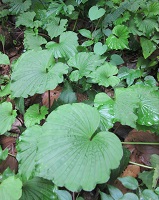Antidiabetic and Regenerative effects of alcoholic corm extract of Nervilia aragoana Gaud. in NIDDM rats
Keywords:
Nervilia aragoana Gaud, Wayanad district, Streptozotocin-nicotinamide induced type 2 diabetes, Antidiabetic activity, Regeneration of kidney tissueAbstract
Nervilia aragoana Gaud. (Orchidaceae) has long been used in the antidiabetic medicinal preparations of traditional healers of Wayanad (Kerala), but antidiabetic and regenerative potential of the plant remain unravelled. The aim of the present study was to investigate the recuperative and regenerative potential of alcoholic stem extract of Nervilia aragoana Gaud. on streptozotocin-nicotinamide induced type 2 diabetic models. Administration of 5mg/kg of plant extract, blood glucose levels of the NIDDM rats showed 65.91 and 76.58 % decrease in the blood glucose levels on 0 and day 30 days respectively. Damages caused to the kidney tissue were negligible or not seen. Serum urea and creatinine levels showed 65.00 % and 71.00% decrease on day 30. LPP levels of kidney and pancreas showed 76.47 % and 74.19% decrease respectively. These results demonstrate significant antidiabetic and regenerative potential of the Nervilia aragoana Gaud. justifying the use of plant in the indigenous system of medicine. Isolation and characterisation of the compound(s) playing pivotal role in the cure would open new vistas in the therapy of type 2 diabetes.
References
Asayama, K., Hayashibe, K., Dobashi, K., Niitsu, T., Miyao, A., Keto, K., 1989. Antioxidant enzyme status and lipid peroxidation in various tissues of diabetic and starved rats. Diabetes 12, 85-89.
Barker, S.B., 1944. The calorimetric determination of urea in blood and urine. Journal of Biological Chemistry 152,453-459.
Bonsness, R.W., Taussky, H.H., 1945. On the colorimetric determination of creatinine by the Jaffe reaction. Journal of Biological Chemistry 158,581-583.
Dilipkumar, E.K., and Janardhana G.R., 2011. Antidiabetic activity of alcoholic stem extract of Nervilia plicata in streptozotocin-nicotinamide induced type 2 diabetic rats. Journal of Ethnopharmacology 133 (2011) 480–483.
Ghosh, M.N., 1984. Toxicity studies. In: Fundamentals of Experimental Pharmacology. Scientific Book Agency, Calcutta, p.153.
Masiello, P., Broca, C., Gross, R., Roye, M., Manteghetti, M., Hillaire, B.D., Novelli, M., Ribes, G., 1998. Development of a new model of type 2 diabetes in adult rats administered with streptozotocin and nicotinamide. Diabetes 47, 224-229.
Moos, N.S., 1980. Gnanas of Vahata, Vaidyasaradhy press, Kottayam, p. 93.
Nesamani, S., 1998. Oushadasasyangal, State Institute of Languages, Kerala, Trivandrum-3 p.449.
Okhawa, H., Ohishi, N., Yagi, K., 1979. Assay for lipid peroxides in animal tissues by thiobarbituric acid reaction. Analytical Biochemistry 95, 351-358.
Palanichamy, S., Nagarajan, S., Devasagayam, M., 1988. Effect of Cassia alata leaf extract on hyperglycaemic rats. Journal of Ethnopharmacology 22, 81-89.
Sehnaz, B., Nuriye, A., Nurten, O., Meliha, S.I., Ayse, C., Alper, O., Refiye, Y., 2003. Effects of Aloe vera (L) Burm.fil leaf gel and pulp extracts on kidney in type-II diabetic rats. Indian Journal of Experimental Biology 42, 48-52.
Sivarajan, V.V., 1999.Ayurvedic drugs and their plant sources, Oxford & IBH publishing Co. pvt.Ltd, p.336.
Turner, M.A., 1965.Screening Methods in Pharmacology. Academic Press, New York, p. 26.



